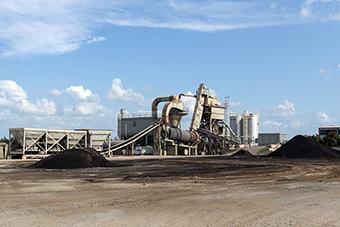Paving and Roofing Materials Effluent Guidelines
 EPA promulgated the Paving and Roofing Materials (Tars and Asphalt) Effluent Guidelines (40 CFR Part 443) in 1975. The regulation covers direct
EPA promulgated the Paving and Roofing Materials (Tars and Asphalt) Effluent Guidelines (40 CFR Part 443) in 1975. The regulation covers direct![]() direct dischargerA point source that discharges pollutants to waters of the United States, such as streams, lakes, or oceans. and indirect
direct dischargerA point source that discharges pollutants to waters of the United States, such as streams, lakes, or oceans. and indirect![]() indirect dischargerA facility that discharges pollutants to a publicly owned treatment works (municipal sewage treatment plant). dischargers. The Effluent Guidelines are incorporated into NPDES permits for direct dischargers and into permits or other control mechanisms for indirect dischargers (see Pretreatment Program).
indirect dischargerA facility that discharges pollutants to a publicly owned treatment works (municipal sewage treatment plant). dischargers. The Effluent Guidelines are incorporated into NPDES permits for direct dischargers and into permits or other control mechanisms for indirect dischargers (see Pretreatment Program).
- What is the Paving and Roofing Materials Industry?
- Pollutants and Subcategories
- Rulemaking History
- Additional Information
What is the Paving and Roofing Materials Industry?
Most asphalt and asphalt products are manufactured from the residues generated when crude petroleum is distilled.
- Asphalt emulsion plants produce blown asphalt (forcing hot air through crude asphalt and mixing with water and chemicals) for use in roofing or paving materials.
- Asphalt concrete plants manufacture paving materials such as black top (asphalt mixed with crushed rock or gravel).
- Asphalt roofing plants manufacture asphalt felts, shingles, and other products, such as impregnated asphalt siding, expansion joints, canal liners, roofing cements, tars and pitches, and tar paper.
- Floor covering plants manufacture linoleum floor coverings and printed asphalt felt floor coverings. The coverings are made by saturating organic felt with asphalt and then painting or embedding a design on one side of the felt.
At the time of the 1975 rulemaking, there were approximately 5,100 plants in the Paving and Roofing Materials category; mostly asphalt concrete plants.
- Residue from wet scrubbers used to control air pollution emissions
- Cleanup water
- Product cooling water
Paving and Roofing Materials (Tars & Asphalt) is included within the following North American Industry Classification System (NAICS) groups:
- 324121: Asphalt Paving Mixture and Block Manufacturing
- 324122: Asphalt Shingle and Coating Materials Manufacturing
- 326192: Resilient Floor Covering Manufacturing
The NAICS listing is provided as a guide and does not define the coverage of the Paving and Roofing Materials category. For precise definitions of coverage, see the applicability sections in 40 CFR Part 443.
Pollutants and Subcategories
Regulated Pollutants
- TSS
- oil and grease
- pH
Regulation Subcategories
- Asphalt Emulsion
- Asphalt Concrete
- Asphalt Roofing
- Linoleum and Printed Asphalt Felt
Rulemaking History
- Documents, including:
- Final Rule (July 25, 1975)
- Development Document (July 1975)
Industry description, wastewater characterization, treatment technologies, regulatory compliance cost estimates and pollutant loadings for the final rule - Proposed Rule (January 10, 1975)
Additional Information
For additional information regarding Paving and Roofing Materials Effluent Guidelines, please contact Jezebele Alicea-Virella (alicea.jezebele@epa.gov) or 808-539-0541.
